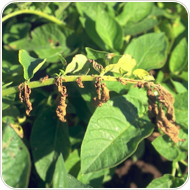Potato Early Dying

Potato early dying (PED), caused primarily by the soilborne fungi Verticillium dahliae Kleb and V. albo-atrum Reinke and Berthold, is characterized by unilateral wilting of leaves, chlorosis, and premature senescence. Yield losses up to 50% can occur in sandy soils and 20-30% losses are common. In addition, the disease affects both tuber size and specific gravity. Soil fumigation is the most widely practiced control tactic where potatoes are grown. In the state of Wisconsin, between 60 and 70% of potato acreage is fumigated each year with metam sodium. At a cost of approximately $700 per hectare for metam sodium, the financial impact of disease prevention alone is substantial. Sustainability efforts by major wholesale and retail French fry distributors, such as Sysco and McDonald’s, focus on reducing the pesticide impact of the potato crop on the environment, with metam sodium use coming under close scrutiny. Metam sodium has recently gone through a re-registration process with the Environmental Protection Agency, with numerous restrictions placed on its use in order to reduce human and animal exposure to the volatiles released during soil treatments.
Previous Halterman Lab scientists working on the project:
Pedro Uribe – Postdoc, Department of Plant Pathology (Pedro is currently a Plant Pathologist at the Colombian Corporation of Agricultural Research - AGROSAVIA)
One likely candidate for a potato Verticillium wilt (VW) resistance gene is a relative of the tomato Ve gene, which has been successfully used in tomato breeding for several decades. The Halterman lab was able to find a homolog to this gene within the genome of a segregating population in S. chacoense-derived hybrids. Subsequently a genomic marker linked to this gene was developed but its utility limited to this hybrid population. To provide the community with an improved molecular marker for Ve resistance and to find alternative sources of resistance to this pathogen, we embraced the screening of wild Solanum species for resistance and susceptibility to Verticillium dahliae. The screening process was accomplished using a seedling dip assay developed in house which readily exposes the host to a calibrated amount of inoculum inducing disease in a matter of weeks. The scoring system used consists of a 1 to 5 rating system where 5 indicated the lack of symptoms and 1 almost death. The last disease rating of a particular population was taken as the overall experimental disease rating for that particular population. A population was rated as susceptible to the pathogen when the experimental disease rating was at least one unit lower than the rating of the mock-inoculated controls (roots dipped in sterile water).
Austin Meier – PhD student, Plant Breeding and Genetics Program (Austin is currently a Breeding Systems Analyst at BASF, Oregon)
My research is focused mostly around Verticillium wilt resistance in potato with an emphasis on understanding resistance conferred by the Ve gene. The Ve gene was identified in tomato, and has been used successfully in breeding programs to grant tomatoes resistance to Verticillium wilt for over 50 years. A homolog of the Ve gene exists in potato and my research focuses on categorizing the resistance mechanism of this gene.
The coding regions of both the susceptible allele and resistant allele were cloned previously. I have since cloned the suspected resistant allele, including it’s native promoter, into a binary vector (pGWB4). I am working to transform these alleles into potato cultivars that are known to be susceptible to Verticillium wilt, and confirm that it is the Ve gene that is conferring resistance to the pathogen. I have also managed to clone the native promoters of both the resistant allele. I am evaluating the expression levels of the C545 promoter versus the V67 promoter to determine if the resistance conferred by the C545 allele is due to differences in expression.
